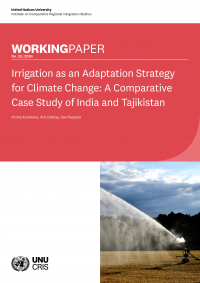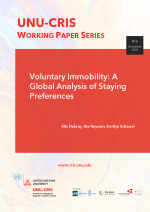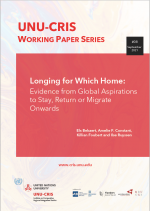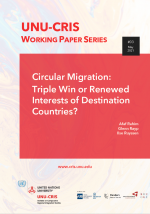Irrigation as an Adaptation Strategy for Climate Change: A Comparative Case Study of India and Tajikistan

In this paper, we conduct a comprehensive analysis of the role played by irrigation in protecting the incomes and livelihoods of agricultural workers in the face of climate change. To this end, we employ subnational irrigation statistics, which rarely appear in the academic literature due to data availability constraints and analyse them against a range of socio-economic and environmental indicators. To limit the variation in circumstances and context, we focus on two specific cases: India and Tajikistan, both among the world’s most irrigated countries, with approximately 70% of the total cultivated area equipped for irrigation. We conduct a comprehensive comparative case study of the two countries’ water and irrigation sectors concerning their socioeconomic contexts, climate conditions, andland and water resources. Irrigation development and relevant management frameworks are evaluated at different levels of governance – national, regional, and local – while taking into account geographic variation. Our analysis deploys longitudinal subnational statistics and demonstrates significant regional heterogeneity in irrigation deployment, which may be attributed to regions’ varying water requirements, as well as financial and institutional capabilities to manage irrigation effectively.
So far, in the growing body of literature on irrigation as a solution for climate change-related shocks, it has not been fully explored how the efficient management of irrigation within countries can help tackle both economic and environmental issues at once, while considering all kinds of limitations they may face. The contribution of this article is to bridge the gap between scarce subnational statistics and scattered evidence from academic literature and reports by international and local development agencies to develop a holistic strategy for the irrigation sector in India and Tajikistan. Our findings aim to inform the scientific management of water resources, and irrigation by policymakers in India, Tajikistan, and other countries and regions worldwide that face similar issues of food insecurity, rural poverty, environmental degradation, and climate-induced migration.
Specifically, we put forward an extensive set of policy recommendations that can be beneficial for water and irrigation sectors in India and Tajikistan, with the goal of ensuring physical safety, food security, and decent economic and ecological conditions for the population. The main direction we propose is to reconcile water supply and demand across countries’ regions through management reforms, infrastructural development, and improved water use efficiency and cropping patterns.
Our recommendations cover a wide range of areas for potential improvement, including the quality of infrastructure used for irrigation, drainage, and water storage, the extent of water conservation and use efficiency, provision of training and agricultural extension services, involvement of stakeholders at various levels in all stages of water and irrigation management, climate-smart optimization of cropping plans, and disaster preparedness.




